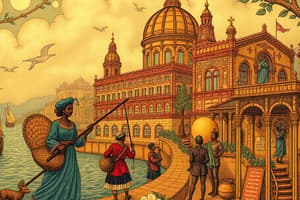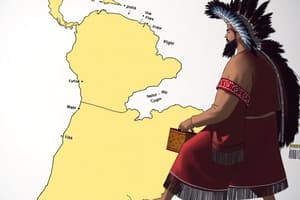Podcast
Questions and Answers
What was a significant impact of the introduction of horses to the Great Plains tribes?
What was a significant impact of the introduction of horses to the Great Plains tribes?
- Enhanced hunting efficiency (correct)
- Improvement in trade networks
- Development of permanent settlements
- Increased agricultural production
What motivated European exploration in the 15th century?
What motivated European exploration in the 15th century?
- Desire to spread indigenous cultures
- The establishment of democratic governments
- The quest for new trade routes and wealth (correct)
- Advancements in agricultural techniques
Which civilization is known for its extensive trade networks and calendar systems between 300 and 800 CE?
Which civilization is known for its extensive trade networks and calendar systems between 300 and 800 CE?
- Aztecs
- Mayas (correct)
- Hohokam
- Incas
What was a primary purpose of the Encomienda system established by Spanish settlers?
What was a primary purpose of the Encomienda system established by Spanish settlers?
Which tribe is a notable example from the Iroquois Confederation known for its matriarchal lineage?
Which tribe is a notable example from the Iroquois Confederation known for its matriarchal lineage?
What was one of the consequences of the Columbian Exchange for the Americas?
What was one of the consequences of the Columbian Exchange for the Americas?
What led to the division of the Americas between Spain and Portugal?
What led to the division of the Americas between Spain and Portugal?
Which of the following crops was introduced to Europe as a result of the Columbian Exchange?
Which of the following crops was introduced to Europe as a result of the Columbian Exchange?
What was a key feature of the Oregon Compromise of 1846?
What was a key feature of the Oregon Compromise of 1846?
What was the main consequence of the Mexican-American War?
What was the main consequence of the Mexican-American War?
Which legislative act allowed popular sovereignty in Kansas and Nebraska, leading to conflict?
Which legislative act allowed popular sovereignty in Kansas and Nebraska, leading to conflict?
Which event was prompted by the election of Abraham Lincoln in 1860?
Which event was prompted by the election of Abraham Lincoln in 1860?
What was one of the primary purposes of the Emancipation Proclamation issued in 1863?
What was one of the primary purposes of the Emancipation Proclamation issued in 1863?
Which amendments were created during the Reconstruction period to protect the rights of former slaves?
Which amendments were created during the Reconstruction period to protect the rights of former slaves?
What was a major limitation faced during the Reconstruction era as a form of resistance?
What was a major limitation faced during the Reconstruction era as a form of resistance?
What marked the end of Reconstruction in the United States?
What marked the end of Reconstruction in the United States?
What was a consequence of the Alien and Sedition Acts?
What was a consequence of the Alien and Sedition Acts?
Which event is marked by the peaceful transition of power from Federalists to Democratic-Republicans?
Which event is marked by the peaceful transition of power from Federalists to Democratic-Republicans?
What was one effect of the Missouri Compromise?
What was one effect of the Missouri Compromise?
Which movement emphasized personal salvation and led to activism in various social reforms?
Which movement emphasized personal salvation and led to activism in various social reforms?
What did the Tariff of 1816 aim to achieve?
What did the Tariff of 1816 aim to achieve?
What constitutional question was raised by the Louisiana Purchase?
What constitutional question was raised by the Louisiana Purchase?
Which Supreme Court case established the principle of judicial review?
Which Supreme Court case established the principle of judicial review?
What ideology promoted the U.S. expansion across North America in the mid-19th century?
What ideology promoted the U.S. expansion across North America in the mid-19th century?
Which event intensified debates over slavery in the newly acquired territories after the Mexican-American War?
Which event intensified debates over slavery in the newly acquired territories after the Mexican-American War?
What did the Indian Removal Act of 1830 lead to?
What did the Indian Removal Act of 1830 lead to?
Which of the following was a characteristic of the economic transformations during 1800-1848?
Which of the following was a characteristic of the economic transformations during 1800-1848?
Which political party emerged in opposition to Andrew Jackson's policies?
Which political party emerged in opposition to Andrew Jackson's policies?
What was a major consequence of sectionalism in the United States during the 19th century?
What was a major consequence of sectionalism in the United States during the 19th century?
What was a key outcome of the Civil War?
What was a key outcome of the Civil War?
What was one significant consequence of the Middle Passage for enslaved Africans?
What was one significant consequence of the Middle Passage for enslaved Africans?
What impact did Bartolomé de Las Casas have on Spanish policy towards Native Americans?
What impact did Bartolomé de Las Casas have on Spanish policy towards Native Americans?
How did French colonial policy differ from English colonial policy regarding Native populations?
How did French colonial policy differ from English colonial policy regarding Native populations?
What economic system was enforced by the Navigation Acts?
What economic system was enforced by the Navigation Acts?
What was a major outcome of Metacom’s War for Native Americans?
What was a major outcome of Metacom’s War for Native Americans?
What was one consequence of the transition from indentured servitude to African slavery?
What was one consequence of the transition from indentured servitude to African slavery?
What was a key factor driving the establishment of the Southern Colonies?
What was a key factor driving the establishment of the Southern Colonies?
Which document emphasized the concept of natural rights as justification for rebellion?
Which document emphasized the concept of natural rights as justification for rebellion?
What major conflict led to increased tensions between British colonies and Great Britain?
What major conflict led to increased tensions between British colonies and Great Britain?
Which two parties had conflicting views on the role of federal versus state governments?
Which two parties had conflicting views on the role of federal versus state governments?
What was one significant impact of the Great Awakening?
What was one significant impact of the Great Awakening?
What was the main characteristic of English settlers' view toward Native cultures?
What was the main characteristic of English settlers' view toward Native cultures?
Which event is often cited as the turning point of the Revolutionary War?
Which event is often cited as the turning point of the Revolutionary War?
What was a core reason for the growing colonial resentment against British taxes after the French and Indian War?
What was a core reason for the growing colonial resentment against British taxes after the French and Indian War?
What was one significant change initiated by the Articles of Confederation?
What was one significant change initiated by the Articles of Confederation?
Flashcards
Columbian Exchange
Columbian Exchange
The movement of plants, animals, diseases, and people between the Old World (Europe, Asia, and Africa) and the New World (the Americas) after Christopher Columbus's voyages in 1492.
Encomienda System
Encomienda System
A system established by the Spanish in the Americas that granted settlers control over Native American labor in exchange for 'protection' and Christian conversion. This often resulted in the forced labor of indigenous people in fields and mines.
Inca Empire
Inca Empire
A powerful empire in Peru known for its potato cultivation, advanced road systems, and innovative terraced farming techniques.
Maya Civilization
Maya Civilization
Signup and view all the flashcards
Aztec Empire
Aztec Empire
Signup and view all the flashcards
Introduction of Horses to the Americas
Introduction of Horses to the Americas
Signup and view all the flashcards
European Exploration
European Exploration
Signup and view all the flashcards
Treaty of Tordesillas
Treaty of Tordesillas
Signup and view all the flashcards
Asiento System
Asiento System
Signup and view all the flashcards
Middle Passage
Middle Passage
Signup and view all the flashcards
Spanish Policy in the Americas
Spanish Policy in the Americas
Signup and view all the flashcards
Bartolomé de Las Casas
Bartolomé de Las Casas
Signup and view all the flashcards
Valladolid Debate
Valladolid Debate
Signup and view all the flashcards
Transatlantic Slave Trade
Transatlantic Slave Trade
Signup and view all the flashcards
Contextualizing Period 2 (1607-1754)
Contextualizing Period 2 (1607-1754)
Signup and view all the flashcards
Period 2 (1607-1754)
Period 2 (1607-1754)
Signup and view all the flashcards
Indentured Servitude
Indentured Servitude
Signup and view all the flashcards
Great Awakening
Great Awakening
Signup and view all the flashcards
Salutary Neglect
Salutary Neglect
Signup and view all the flashcards
Triangular Trade
Triangular Trade
Signup and view all the flashcards
Mercantilism
Mercantilism
Signup and view all the flashcards
Alien and Sedition Acts
Alien and Sedition Acts
Signup and view all the flashcards
Westward Expansion and Native American Conflicts
Westward Expansion and Native American Conflicts
Signup and view all the flashcards
Market Revolution
Market Revolution
Signup and view all the flashcards
Manifest Destiny
Manifest Destiny
Signup and view all the flashcards
Marbury v. Madison
Marbury v. Madison
Signup and view all the flashcards
McCulloch v. Maryland
McCulloch v. Maryland
Signup and view all the flashcards
Gibbons v. Ogden
Gibbons v. Ogden
Signup and view all the flashcards
Era of Good Feelings
Era of Good Feelings
Signup and view all the flashcards
Missouri Compromise (1820)
Missouri Compromise (1820)
Signup and view all the flashcards
Election of 1800
Election of 1800
Signup and view all the flashcards
The Civil War
The Civil War
Signup and view all the flashcards
Reconstruction
Reconstruction
Signup and view all the flashcards
Indian Removal Act (1830)
Indian Removal Act (1830)
Signup and view all the flashcards
Cotton Gin
Cotton Gin
Signup and view all the flashcards
Henry Clay's American System
Henry Clay's American System
Signup and view all the flashcards
Mexican Cession
Mexican Cession
Signup and view all the flashcards
Gadsden Purchase
Gadsden Purchase
Signup and view all the flashcards
Impact of Mexican-American War on Slavery Debate
Impact of Mexican-American War on Slavery Debate
Signup and view all the flashcards
Compromises of 1850
Compromises of 1850
Signup and view all the flashcards
Popular Sovereignty
Popular Sovereignty
Signup and view all the flashcards
Kansas-Nebraska Act
Kansas-Nebraska Act
Signup and view all the flashcards
Underground Railroad
Underground Railroad
Signup and view all the flashcards
Impact of the Emancipation Proclamation
Impact of the Emancipation Proclamation
Signup and view all the flashcards
Study Notes
Period 1 (1491–1607): Indigenous Societies
- Native American populations existed for at least 10,000-40,000 years.
- By 1491, the population was estimated at 50-100 million, spanning diverse cultures and languages.
- Central and South American cultures included the Mayans (with advanced urban centers and trade), Aztecs (dominating central Mexico with massive capital Tenochtitlan), and Incas (known for sophisticated agriculture).
- North American cultures were more diverse, with smaller populations and varied social structures. Key groups included Southwest tribes (e.g., Hohokam, Anasazi) utilizing irrigation, the Great Plains tribes (nomadic buffalo hunters), the Mississippi River Valley groups like Cahokia, Northeast tribes (Iroquois Confederation with longhouses), and Atlantic Seaboard tribes adapting to river-based resources.
Period 1 (1491–1607): European Exploration
- European motivations included wealth from Asian trade, spreading Christianity (post-Reformation), and Renaissance advancements in shipbuilding, mapping, and printing.
- Key explorers were Christopher Columbus (funded by Spain, mistakenly believing he reached Asia), Vasco da Gama (first to sail to India via the Cape of Good Hope), Cortés and Pizarro (who conquered the Aztecs and Incas respectively).
- The Treaty of Tordesillas (1494) divided the Americas between Spain and Portugal.
Period 1 (1491–1607): Columbian Exchange
- Crops like corn, potatoes, tomatoes, and tobacco were introduced to Europe, boosting populations.
- Diseases like smallpox and measles devastated Native American populations.
- Europe received syphilis from the Americas.
- Europe brought crops like sugar cane, wheat, and coffee to the Americas.
- Animals like horses, pigs, and cattle transformed Native American societies.
Period 1 (1491–1607): Labor and Slavery
- The Encomienda System assigned Native American labor to Spanish settlers, often exploitative.
- The Asiento System imported enslaved Africans to replace Native American labor.
- The Middle Passage transported millions of Africans, with high mortality.
- Native Americans and Africans resisted forced labor through revolts and preservation of culture.
Period 1 (1491–1607): Cultural Interactions
- Spanish policy focused on dominating and exploiting Native populations, though Bartolomé de Las Casas advocated for their rights, leading to the New Laws of 1542.
- The Valladolid Debate (1550-1551) raised critical questions about Native Americans' rights and humanity.
- English policy transitioned from cooperation to dominance through displacement and land seizure, viewing Native cultures as inferior.
- French policy focused on trade partnerships and alliances, often less exploitative than other European powers.
Period 2 (1607–1754): Colonization in North America
- British presence dominated this period, establishing colonies along the Atlantic coast.
- Colonial systems varied among European powers: Spanish focused on conversion and resource extraction; French on fur trade and alliances; Dutch on coastal trade posts; British on self-sufficient farms and land ownership.
- Labor systems evolved from failed Native American enslavement to indentured servitude, ultimately transitioning to African slavery after the 1660s.
- Colonies developed from survival outposts to permanent settlements including farms, towns, and cities.
Period 2 (1607–1754): Regional Development
- New England colonies were religiously motivated (e.g., Plymouth, Massachusetts Bay).
- Chesapeake colonies (Virginia, Maryland) were driven by tobacco cultivation.
- Middle colonies had diverse populations and economies based on trade and farming.
- Southern Colonies, including South Carolina (focused on rice and indigo) and Georgia (originally as a buffer), developed a plantation economy reliant on enslaved labor.
Period 2 (1607–1754): Key Developments
- The Great Awakening emphasized personal piety and challenged religious authority.
- Colonial governance evolved towards self-rule due to British "salutary neglect," featuring institutions like the Virginia House of Burgesses and Fundamental Orders of Connecticut.
- Triangular Trade connected the colonies, Africa, and Europe.
- Mercantilist policies dictated by the Navigation Acts, though boosting British economy in theory, strained relations with the colonies.
- Conflicts with Native Americans arose, prominently Metacom's War in New England and Bacon's Rebellion in Virginia.
Period 3 (1754–1800): Transition to Independence
- The period marked the transformation of British colonies into independent United States, involving war with France, burgeoning independence movements, establishment of new governments, and the nation's initial challenges.
Period 3 (1754–1800): Key Events
- The French and Indian War (Seven Years' War) over territorial claims led to British victory, changing territorial control and escalating colonial tensions.
- Growing colonial resentment against British policies emerged, including the Proclamation of 1763 restricting westward expansion and new taxation policies like the Sugar Act and Stamp Act.
- The Revolutionary War (1775–1783) resulted from mounting tensions "taxation without representation."
- Key documents emerged, including the Declaration of Independence, Articles of Confederation (with strengths during the war but weaknesses in central authority), and the U.S. Constitution (creating a federal system with separation of powers, reinforced by the Bill of Rights).
Period 3 (1754–1800): Conflicting Visions of Government
- Federalists (Hamilton, Adams) favored a strong central government and industrial growth, countered by Democratic-Republicans (Jefferson, Madison) advocating for states' rights and agricultural focus.
- The Alien and Sedition Acts of 1798 restricted speech and targeted immigrants.
Period 3 (1754–1800): Economic, Political, and Cultural Changes
- Early American economics faced challenges from debts, debates about national banks, and escalating conflicts with Native Americans due to westward expansion.
- Cultural identity was shaped by Enlightenment ideals, leading towards a unique American identity separate from its European influences.
- The U.S. navigated foreign affairs and relations with Britain and Spain.
Period 4 (1800–1848): Growth and Division
- The period encompassed economic expansion (agriculture, industrialization, transportation advances), growing democracy (with the weakening of property ownership as a voting requirement), and a strengthening of American identity.
- Territorial expansion saw the doubling of U.S. territory with the Louisiana Purchase.
Period 4 (1800–1848): Political Developments
- Political parties evolved – Federalists faded, Democratic-Republicans (Jeffersonian) and Jacksonian Democrats rose, with Whigs forming as opposing presence.
- The Election of 1800 (Revolution of 1800) marked a peaceful transition in power.
- The Era of Good Feelings had a façade of unity, hiding growing regional divisions over issues like tariffs and slavery.
- The Missouri Compromise attempted to balance free and slave states.
Period 4 (1800–1848): Economic Transformations
- The Market Revolution changed from subsistence farming to commercial agriculture.
- Regional specialization arose (North - industry, South - cotton and slavery, West - grain and livestock).
- Transportation advancements included canals and railroads.
- Technological innovations such as the cotton gin boosted productivity.
Period 4 (1800–1848): Reform Movements
- The Second Great Awakening sparked social activism around abolition, temperance, and women's rights.
- Abolitionist movements sought to end slavery through methods like the Underground Railroad.
- Reform efforts aimed at expanding education and addressing prison and asylum issues alongside the temperance movement.
Period 4 (1800–1848): Territorial Expansion
- The Louisiana Purchase dramatically expanded U.S. territory.
- The acquisition of territory, and the resulting conflicts with Native Americans (Indian Removal Act, Trail of Tears) and resistance from leaders like Tecumseh, further intensified the tensions.
- Manifest Destiny fostered desires for further expansion.
Period 5 (1844–1877): Civil War and Reconstruction
- This era was defined by westward expansion and the escalating sectional strife over slavery, which culminated in the Civil War and its aftermath of rebuilding and social reform (Reconstruction).
Period 5 (1844–1877): Territorial Expansion and Conflict
- The ideology of Manifest Destiny fueled territorial expansion, resulting in the annexation of Texas and Oregon, as well as the Mexican Cession and Gadsden Purchase.
- The Mexican-American War over territorial disputes led to the Treaty of Guadalupe Hidalgo, and significant territorial gain from Mexico.
- Growing debates over slavery fueled this expansionism.
Period 5 (1844–1877): Sectionalism and Slavery
- Compromises like the Compromise of 1850 and the Kansas-Nebraska Act attempted to manage the issue of slavery.
Period 5 (1844–1877): The Civil War & Reconstruction
- The Election of 1860 and Southern secession ignited the Civil War.
- The Emancipation Proclamation became a pivotal moment, redefining the war's purpose.
- Key battles (Gettysburg, Antietam, Vicksburg) shaped the conflict's outcome.
- The war's end led to the abolition of slavery (13th Amendment) and attempts at Reconstruction (14th, 15th amendments) to integrate freed slaves into society.
Period 5 (1844–1877): Reconstruction
- Resistance and failures emerged, including Black Codes, sharecropping, and the rise of groups like the Ku Klux Klan, undermining Reconstruction efforts.
- The Compromise of 1877 marked the end of Reconstruction and the rise of Jim Crow laws.
Studying That Suits You
Use AI to generate personalized quizzes and flashcards to suit your learning preferences.




